Analysis of Australian Accounting Standard Setting Environment
VerifiedAdded on 2020/03/02
|6
|1827
|56
Report
AI Summary
This report provides a detailed analysis of the Australian accounting standard setting environment, focusing on the role of the Australian Accounting Standards Board (AASB) and its procedures for incorporating changes from the International Accounting Standards Board (IASB). The report reviews the process by which AASB adopts both international and local issues into Australian accounting standards, ensuring alignment with the IASB while addressing specific Australian requirements. Furthermore, it examines the implications of Exposure Draft ED 116 concerning changes to IAS 16 (Property, Plant, and Equipment), discussing the potential impact on companies, particularly those in the manufacturing sector, and evaluating the effectiveness of a 'one size fits all' approach in international accounting standards. The report highlights the importance of uniform and comparable financial statements, while also acknowledging the need for flexibility to address country-specific issues and the role of the AASB in maintaining the integrity and relevance of financial reporting within the Australian context.
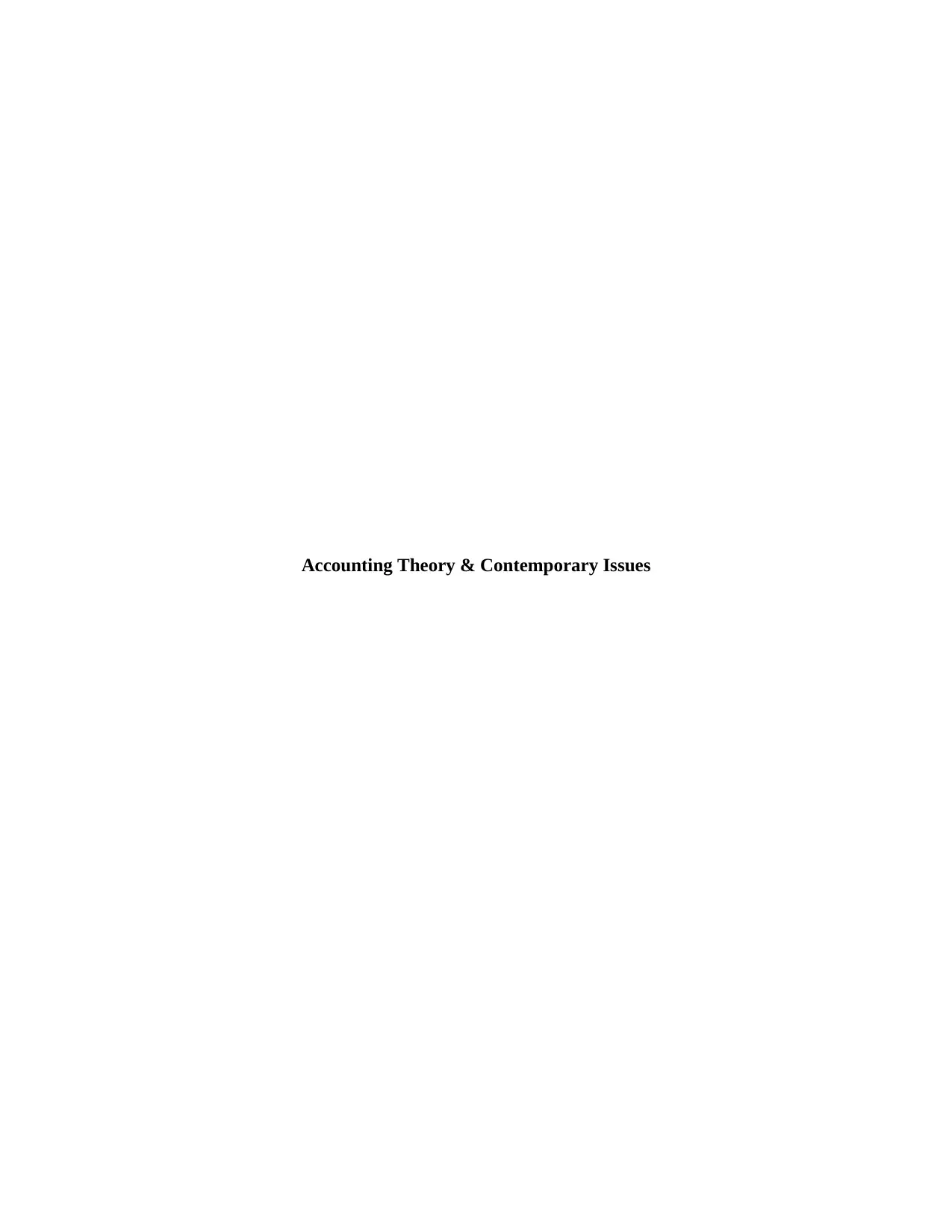
Accounting Theory & Contemporary Issues
Paraphrase This Document
Need a fresh take? Get an instant paraphrase of this document with our AI Paraphraser

Introduction
The present research paper aims to discuss and analyze the Australian accounting
standard setting environment. In this context, the report presents a literature review in relation to
the procedures adopted by the AASB for incorporating changes into international accounting
standards. Also, it demonstrates the process through which AASB adopts local and Australian
issues into Australian accounting standards. In addition to this, a report is presented at last in
response to the call for comment in relation an Exposure Draft ED 116 on the AASB website.
Part A: Literature Review
International accounting standards changes adoption into the Australian accounting
standards
As per the information obtained from Australian Accounting Standards Board (2017), the
AASB (Australian Accounting Standards Board) develop accounting policies and procedures to
be followed by the businesses operating within the country for developing their financial reports.
The accounting policies and procedures adopted by the AASB are developed in accordance with
the IASB (International Accounting Standard Board) rules and conventions. The AASB has
made the Australian accounting standards as equivalent to IASB in the year 2004 as pre the
strategic direction of the Financial Reporting Council. The AASB complies with the IASB
standards by integrating the content and words of the International Financial Reporting
Standards. The AASB modifies the content of IASB in accordance with the legal environment of
Australia. The AASB modifies the wording of the IASB as per the Corporations Act 2001
without affecting the substance of the requirements. The AASB aims at ensuring highest quality
of financial reporting in Australian business firms by adopting the IASB standards (Australian
Accounting Standards Board, 2017).
According to Deegan (2012), the modifications adopted by the IASB are adopted by the
AASB as per the strategic direction of the Financial Reporting Council. The modifications are
also included by the AASB work program with varying level of involvement that can be
substantive or non-substantive. The IASB regulatory adopts and integrates changes into the
accounting standards with the aim of improving the quality of financial reports. The Australian
stakeholders provide recommendations to AASB for consideration of the new issues adopted by
the IASB for improving the relevance and reliability of financial reports. The AASB develops a
project proposal in relation to the proposed changes that identifies and illustrates the potential
benefits raising form adoption of the IASB changes. The project proposal also outlines the cost
of undertaking the proposed changes and analyzes the availability of resources for their
successful adoption. The project proposal is reviewed by the AASB for taking decision in
relation to whether the project should be considered or not. The decision of the Board to not add
a topic to the AASB conventions as per the IASB changes is reflected as formal report into
‘agenda rejection statements’. However, in the situation of adopting the proposed changes, the
The present research paper aims to discuss and analyze the Australian accounting
standard setting environment. In this context, the report presents a literature review in relation to
the procedures adopted by the AASB for incorporating changes into international accounting
standards. Also, it demonstrates the process through which AASB adopts local and Australian
issues into Australian accounting standards. In addition to this, a report is presented at last in
response to the call for comment in relation an Exposure Draft ED 116 on the AASB website.
Part A: Literature Review
International accounting standards changes adoption into the Australian accounting
standards
As per the information obtained from Australian Accounting Standards Board (2017), the
AASB (Australian Accounting Standards Board) develop accounting policies and procedures to
be followed by the businesses operating within the country for developing their financial reports.
The accounting policies and procedures adopted by the AASB are developed in accordance with
the IASB (International Accounting Standard Board) rules and conventions. The AASB has
made the Australian accounting standards as equivalent to IASB in the year 2004 as pre the
strategic direction of the Financial Reporting Council. The AASB complies with the IASB
standards by integrating the content and words of the International Financial Reporting
Standards. The AASB modifies the content of IASB in accordance with the legal environment of
Australia. The AASB modifies the wording of the IASB as per the Corporations Act 2001
without affecting the substance of the requirements. The AASB aims at ensuring highest quality
of financial reporting in Australian business firms by adopting the IASB standards (Australian
Accounting Standards Board, 2017).
According to Deegan (2012), the modifications adopted by the IASB are adopted by the
AASB as per the strategic direction of the Financial Reporting Council. The modifications are
also included by the AASB work program with varying level of involvement that can be
substantive or non-substantive. The IASB regulatory adopts and integrates changes into the
accounting standards with the aim of improving the quality of financial reports. The Australian
stakeholders provide recommendations to AASB for consideration of the new issues adopted by
the IASB for improving the relevance and reliability of financial reports. The AASB develops a
project proposal in relation to the proposed changes that identifies and illustrates the potential
benefits raising form adoption of the IASB changes. The project proposal also outlines the cost
of undertaking the proposed changes and analyzes the availability of resources for their
successful adoption. The project proposal is reviewed by the AASB for taking decision in
relation to whether the project should be considered or not. The decision of the Board to not add
a topic to the AASB conventions as per the IASB changes is reflected as formal report into
‘agenda rejection statements’. However, in the situation of adopting the proposed changes, the
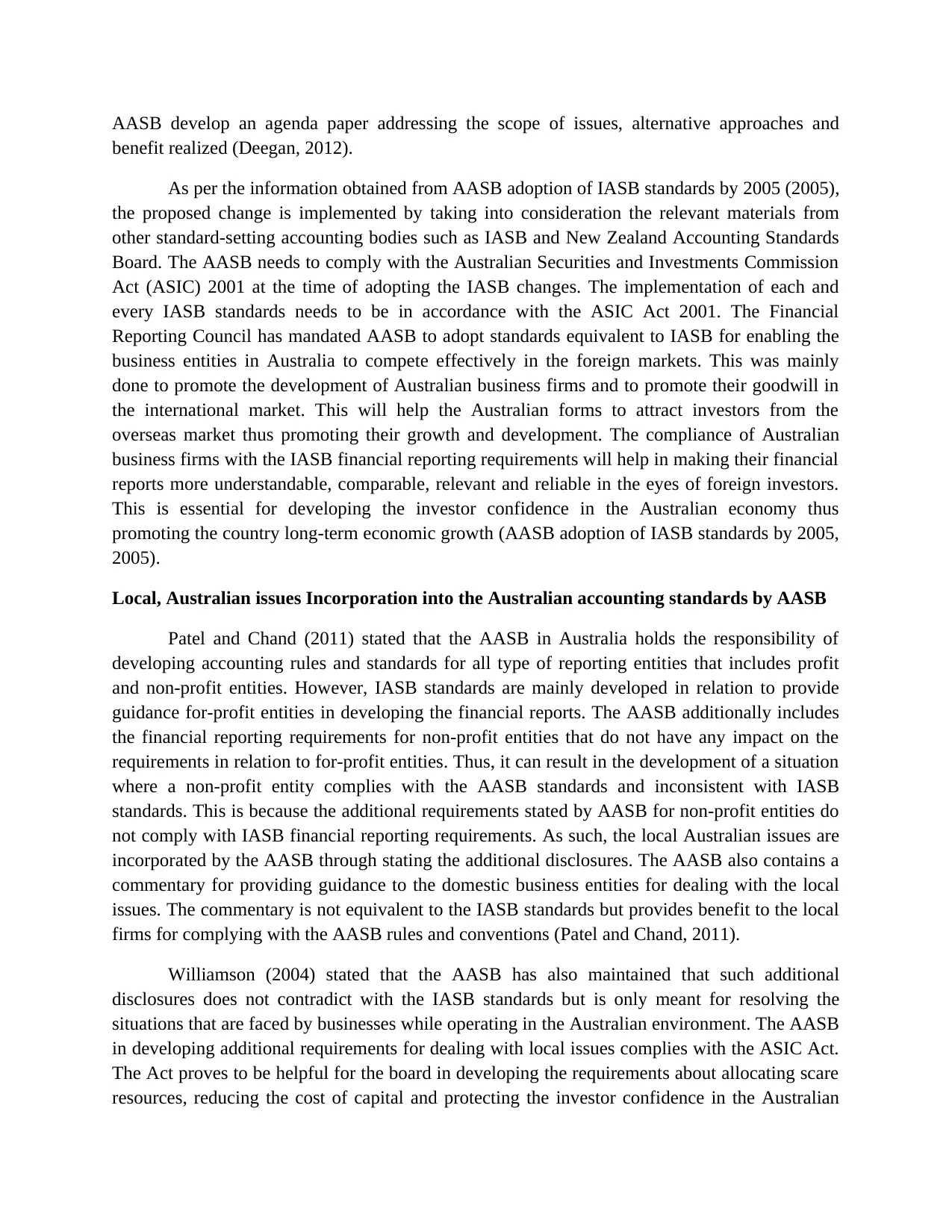
AASB develop an agenda paper addressing the scope of issues, alternative approaches and
benefit realized (Deegan, 2012).
As per the information obtained from AASB adoption of IASB standards by 2005 (2005),
the proposed change is implemented by taking into consideration the relevant materials from
other standard-setting accounting bodies such as IASB and New Zealand Accounting Standards
Board. The AASB needs to comply with the Australian Securities and Investments Commission
Act (ASIC) 2001 at the time of adopting the IASB changes. The implementation of each and
every IASB standards needs to be in accordance with the ASIC Act 2001. The Financial
Reporting Council has mandated AASB to adopt standards equivalent to IASB for enabling the
business entities in Australia to compete effectively in the foreign markets. This was mainly
done to promote the development of Australian business firms and to promote their goodwill in
the international market. This will help the Australian forms to attract investors from the
overseas market thus promoting their growth and development. The compliance of Australian
business firms with the IASB financial reporting requirements will help in making their financial
reports more understandable, comparable, relevant and reliable in the eyes of foreign investors.
This is essential for developing the investor confidence in the Australian economy thus
promoting the country long-term economic growth (AASB adoption of IASB standards by 2005,
2005).
Local, Australian issues Incorporation into the Australian accounting standards by AASB
Patel and Chand (2011) stated that the AASB in Australia holds the responsibility of
developing accounting rules and standards for all type of reporting entities that includes profit
and non-profit entities. However, IASB standards are mainly developed in relation to provide
guidance for-profit entities in developing the financial reports. The AASB additionally includes
the financial reporting requirements for non-profit entities that do not have any impact on the
requirements in relation to for-profit entities. Thus, it can result in the development of a situation
where a non-profit entity complies with the AASB standards and inconsistent with IASB
standards. This is because the additional requirements stated by AASB for non-profit entities do
not comply with IASB financial reporting requirements. As such, the local Australian issues are
incorporated by the AASB through stating the additional disclosures. The AASB also contains a
commentary for providing guidance to the domestic business entities for dealing with the local
issues. The commentary is not equivalent to the IASB standards but provides benefit to the local
firms for complying with the AASB rules and conventions (Patel and Chand, 2011).
Williamson (2004) stated that the AASB has also maintained that such additional
disclosures does not contradict with the IASB standards but is only meant for resolving the
situations that are faced by businesses while operating in the Australian environment. The AASB
in developing additional requirements for dealing with local issues complies with the ASIC Act.
The Act proves to be helpful for the board in developing the requirements about allocating scare
resources, reducing the cost of capital and protecting the investor confidence in the Australian
benefit realized (Deegan, 2012).
As per the information obtained from AASB adoption of IASB standards by 2005 (2005),
the proposed change is implemented by taking into consideration the relevant materials from
other standard-setting accounting bodies such as IASB and New Zealand Accounting Standards
Board. The AASB needs to comply with the Australian Securities and Investments Commission
Act (ASIC) 2001 at the time of adopting the IASB changes. The implementation of each and
every IASB standards needs to be in accordance with the ASIC Act 2001. The Financial
Reporting Council has mandated AASB to adopt standards equivalent to IASB for enabling the
business entities in Australia to compete effectively in the foreign markets. This was mainly
done to promote the development of Australian business firms and to promote their goodwill in
the international market. This will help the Australian forms to attract investors from the
overseas market thus promoting their growth and development. The compliance of Australian
business firms with the IASB financial reporting requirements will help in making their financial
reports more understandable, comparable, relevant and reliable in the eyes of foreign investors.
This is essential for developing the investor confidence in the Australian economy thus
promoting the country long-term economic growth (AASB adoption of IASB standards by 2005,
2005).
Local, Australian issues Incorporation into the Australian accounting standards by AASB
Patel and Chand (2011) stated that the AASB in Australia holds the responsibility of
developing accounting rules and standards for all type of reporting entities that includes profit
and non-profit entities. However, IASB standards are mainly developed in relation to provide
guidance for-profit entities in developing the financial reports. The AASB additionally includes
the financial reporting requirements for non-profit entities that do not have any impact on the
requirements in relation to for-profit entities. Thus, it can result in the development of a situation
where a non-profit entity complies with the AASB standards and inconsistent with IASB
standards. This is because the additional requirements stated by AASB for non-profit entities do
not comply with IASB financial reporting requirements. As such, the local Australian issues are
incorporated by the AASB through stating the additional disclosures. The AASB also contains a
commentary for providing guidance to the domestic business entities for dealing with the local
issues. The commentary is not equivalent to the IASB standards but provides benefit to the local
firms for complying with the AASB rules and conventions (Patel and Chand, 2011).
Williamson (2004) stated that the AASB has also maintained that such additional
disclosures does not contradict with the IASB standards but is only meant for resolving the
situations that are faced by businesses while operating in the Australian environment. The AASB
in developing additional requirements for dealing with local issues complies with the ASIC Act.
The Act proves to be helpful for the board in developing the requirements about allocating scare
resources, reducing the cost of capital and protecting the investor confidence in the Australian
⊘ This is a preview!⊘
Do you want full access?
Subscribe today to unlock all pages.

Trusted by 1+ million students worldwide
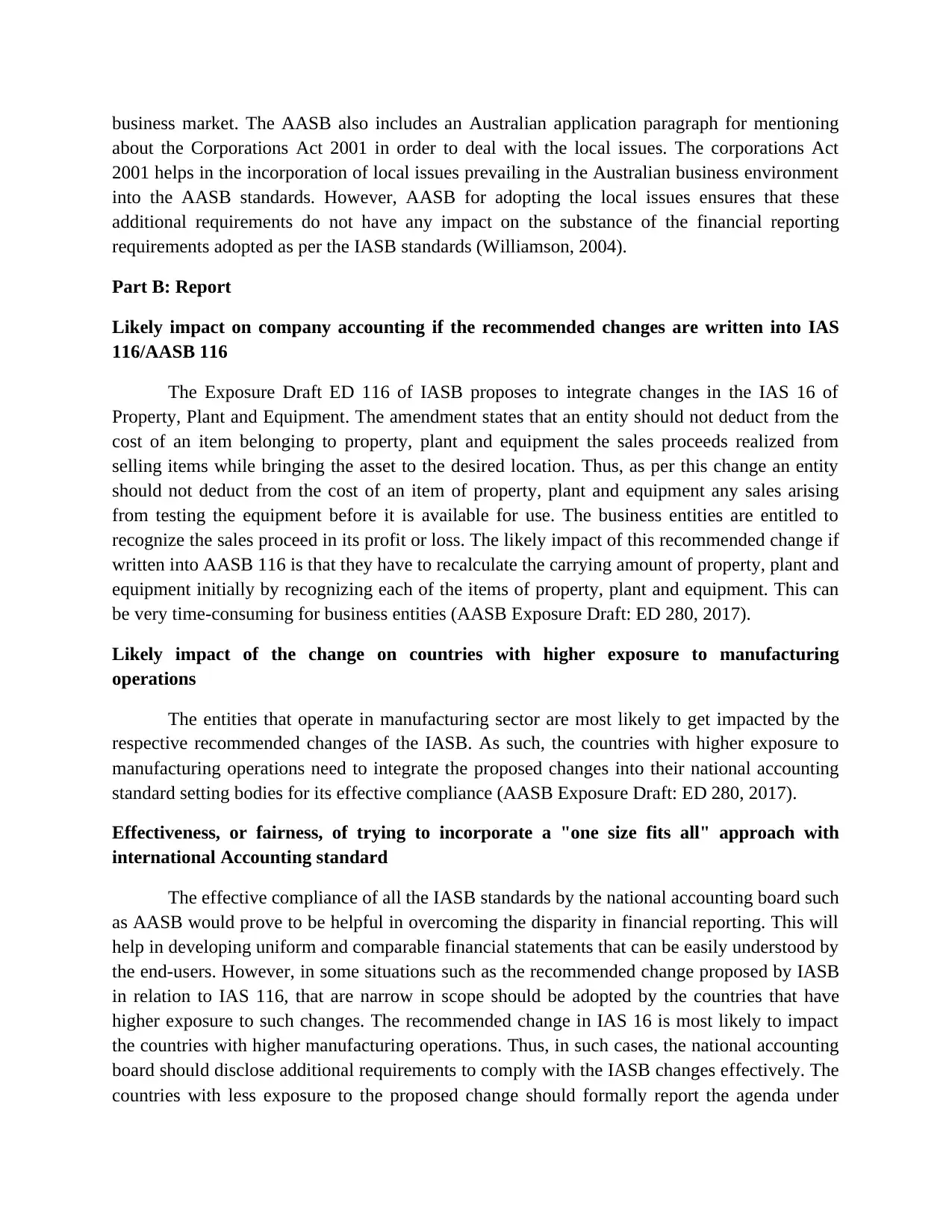
business market. The AASB also includes an Australian application paragraph for mentioning
about the Corporations Act 2001 in order to deal with the local issues. The corporations Act
2001 helps in the incorporation of local issues prevailing in the Australian business environment
into the AASB standards. However, AASB for adopting the local issues ensures that these
additional requirements do not have any impact on the substance of the financial reporting
requirements adopted as per the IASB standards (Williamson, 2004).
Part B: Report
Likely impact on company accounting if the recommended changes are written into IAS
116/AASB 116
The Exposure Draft ED 116 of IASB proposes to integrate changes in the IAS 16 of
Property, Plant and Equipment. The amendment states that an entity should not deduct from the
cost of an item belonging to property, plant and equipment the sales proceeds realized from
selling items while bringing the asset to the desired location. Thus, as per this change an entity
should not deduct from the cost of an item of property, plant and equipment any sales arising
from testing the equipment before it is available for use. The business entities are entitled to
recognize the sales proceed in its profit or loss. The likely impact of this recommended change if
written into AASB 116 is that they have to recalculate the carrying amount of property, plant and
equipment initially by recognizing each of the items of property, plant and equipment. This can
be very time-consuming for business entities (AASB Exposure Draft: ED 280, 2017).
Likely impact of the change on countries with higher exposure to manufacturing
operations
The entities that operate in manufacturing sector are most likely to get impacted by the
respective recommended changes of the IASB. As such, the countries with higher exposure to
manufacturing operations need to integrate the proposed changes into their national accounting
standard setting bodies for its effective compliance (AASB Exposure Draft: ED 280, 2017).
Effectiveness, or fairness, of trying to incorporate a "one size fits all" approach with
international Accounting standard
The effective compliance of all the IASB standards by the national accounting board such
as AASB would prove to be helpful in overcoming the disparity in financial reporting. This will
help in developing uniform and comparable financial statements that can be easily understood by
the end-users. However, in some situations such as the recommended change proposed by IASB
in relation to IAS 116, that are narrow in scope should be adopted by the countries that have
higher exposure to such changes. The recommended change in IAS 16 is most likely to impact
the countries with higher manufacturing operations. Thus, in such cases, the national accounting
board should disclose additional requirements to comply with the IASB changes effectively. The
countries with less exposure to the proposed change should formally report the agenda under
about the Corporations Act 2001 in order to deal with the local issues. The corporations Act
2001 helps in the incorporation of local issues prevailing in the Australian business environment
into the AASB standards. However, AASB for adopting the local issues ensures that these
additional requirements do not have any impact on the substance of the financial reporting
requirements adopted as per the IASB standards (Williamson, 2004).
Part B: Report
Likely impact on company accounting if the recommended changes are written into IAS
116/AASB 116
The Exposure Draft ED 116 of IASB proposes to integrate changes in the IAS 16 of
Property, Plant and Equipment. The amendment states that an entity should not deduct from the
cost of an item belonging to property, plant and equipment the sales proceeds realized from
selling items while bringing the asset to the desired location. Thus, as per this change an entity
should not deduct from the cost of an item of property, plant and equipment any sales arising
from testing the equipment before it is available for use. The business entities are entitled to
recognize the sales proceed in its profit or loss. The likely impact of this recommended change if
written into AASB 116 is that they have to recalculate the carrying amount of property, plant and
equipment initially by recognizing each of the items of property, plant and equipment. This can
be very time-consuming for business entities (AASB Exposure Draft: ED 280, 2017).
Likely impact of the change on countries with higher exposure to manufacturing
operations
The entities that operate in manufacturing sector are most likely to get impacted by the
respective recommended changes of the IASB. As such, the countries with higher exposure to
manufacturing operations need to integrate the proposed changes into their national accounting
standard setting bodies for its effective compliance (AASB Exposure Draft: ED 280, 2017).
Effectiveness, or fairness, of trying to incorporate a "one size fits all" approach with
international Accounting standard
The effective compliance of all the IASB standards by the national accounting board such
as AASB would prove to be helpful in overcoming the disparity in financial reporting. This will
help in developing uniform and comparable financial statements that can be easily understood by
the end-users. However, in some situations such as the recommended change proposed by IASB
in relation to IAS 116, that are narrow in scope should be adopted by the countries that have
higher exposure to such changes. The recommended change in IAS 16 is most likely to impact
the countries with higher manufacturing operations. Thus, in such cases, the national accounting
board should disclose additional requirements to comply with the IASB changes effectively. The
countries with less exposure to the proposed change should formally report the agenda under
Paraphrase This Document
Need a fresh take? Get an instant paraphrase of this document with our AI Paraphraser
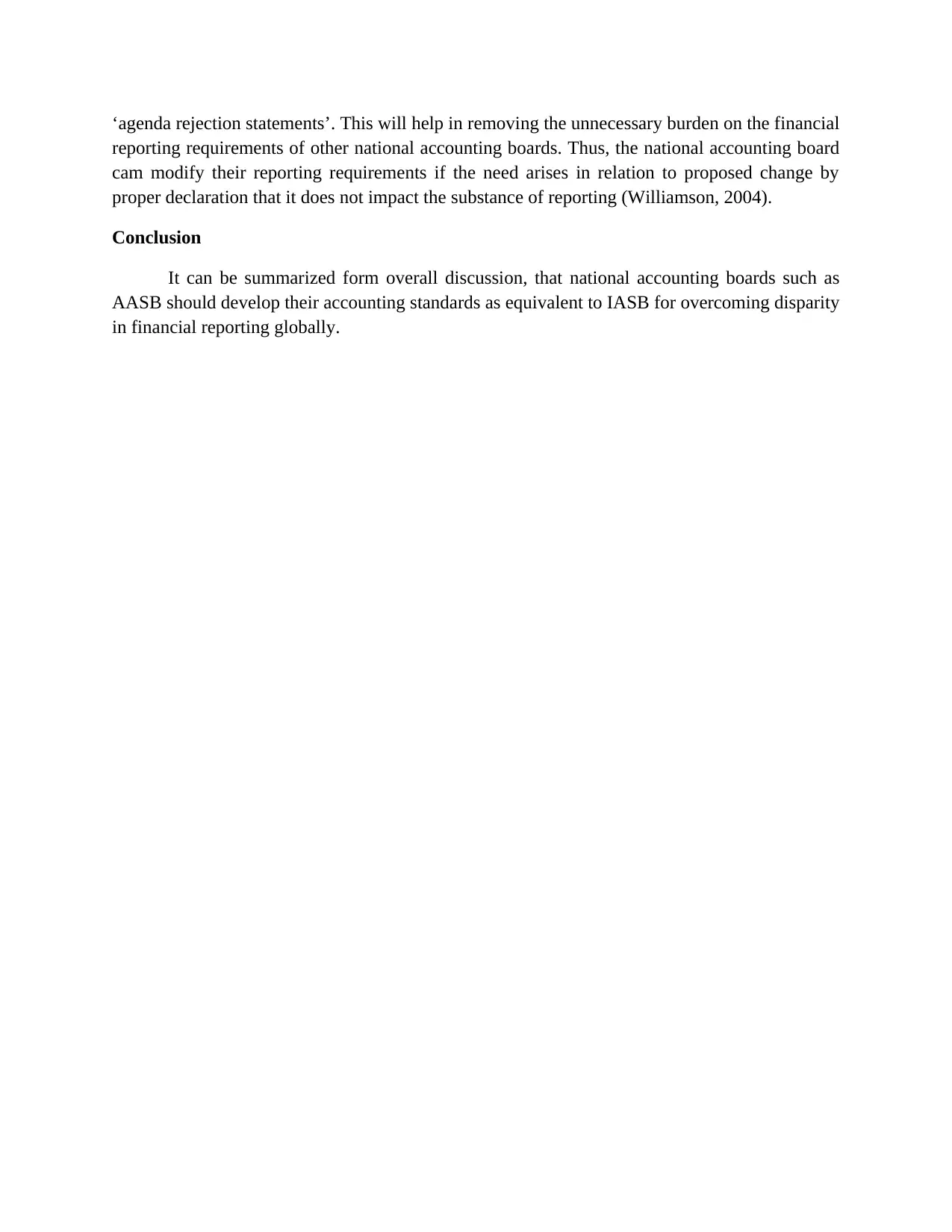
‘agenda rejection statements’. This will help in removing the unnecessary burden on the financial
reporting requirements of other national accounting boards. Thus, the national accounting board
cam modify their reporting requirements if the need arises in relation to proposed change by
proper declaration that it does not impact the substance of reporting (Williamson, 2004).
Conclusion
It can be summarized form overall discussion, that national accounting boards such as
AASB should develop their accounting standards as equivalent to IASB for overcoming disparity
in financial reporting globally.
reporting requirements of other national accounting boards. Thus, the national accounting board
cam modify their reporting requirements if the need arises in relation to proposed change by
proper declaration that it does not impact the substance of reporting (Williamson, 2004).
Conclusion
It can be summarized form overall discussion, that national accounting boards such as
AASB should develop their accounting standards as equivalent to IASB for overcoming disparity
in financial reporting globally.
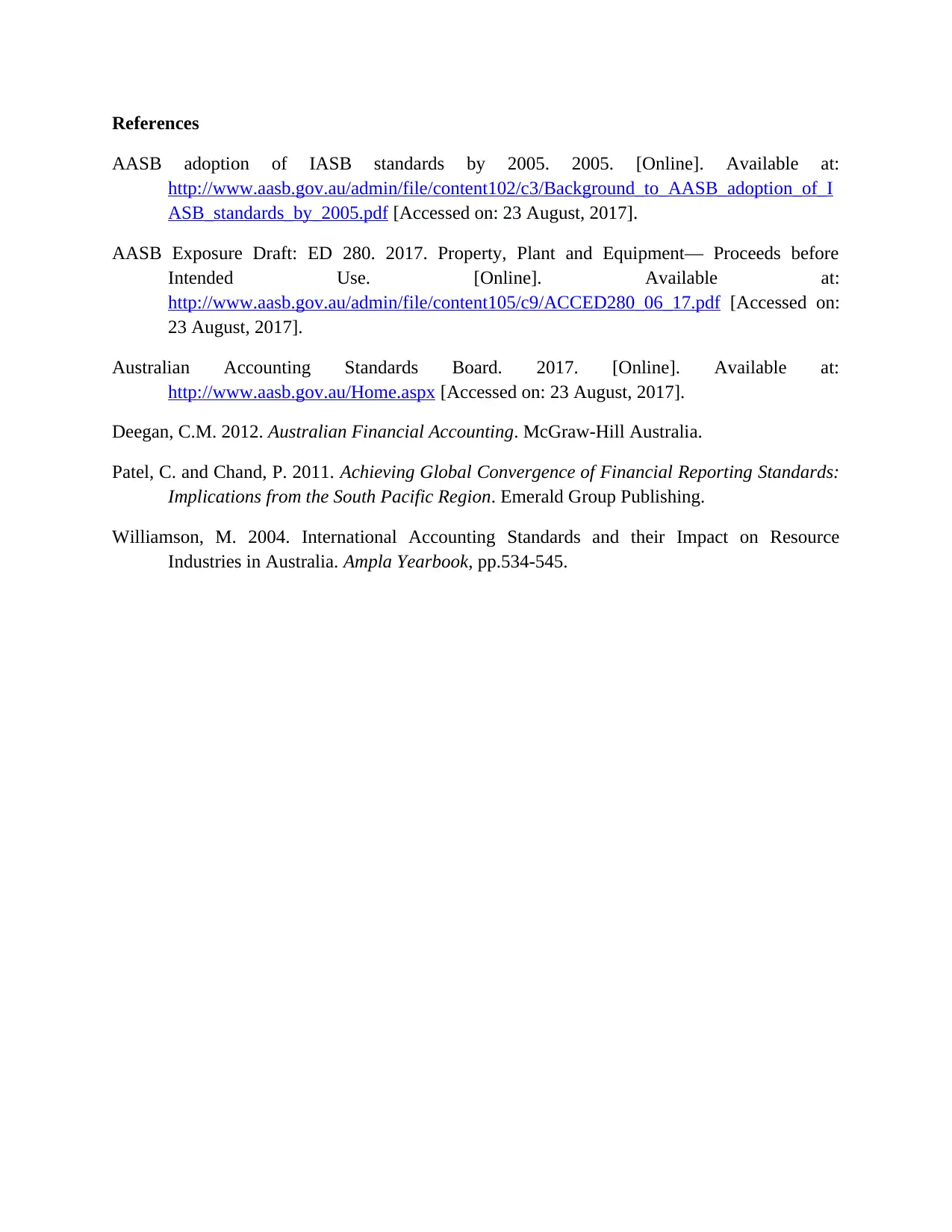
References
AASB adoption of IASB standards by 2005. 2005. [Online]. Available at:
http://www.aasb.gov.au/admin/file/content102/c3/Background_to_AASB_adoption_of_I
ASB_standards_by_2005.pdf [Accessed on: 23 August, 2017].
AASB Exposure Draft: ED 280. 2017. Property, Plant and Equipment— Proceeds before
Intended Use. [Online]. Available at:
http://www.aasb.gov.au/admin/file/content105/c9/ACCED280_06_17.pdf [Accessed on:
23 August, 2017].
Australian Accounting Standards Board. 2017. [Online]. Available at:
http://www.aasb.gov.au/Home.aspx [Accessed on: 23 August, 2017].
Deegan, C.M. 2012. Australian Financial Accounting. McGraw-Hill Australia.
Patel, C. and Chand, P. 2011. Achieving Global Convergence of Financial Reporting Standards:
Implications from the South Pacific Region. Emerald Group Publishing.
Williamson, M. 2004. International Accounting Standards and their Impact on Resource
Industries in Australia. Ampla Yearbook, pp.534-545.
AASB adoption of IASB standards by 2005. 2005. [Online]. Available at:
http://www.aasb.gov.au/admin/file/content102/c3/Background_to_AASB_adoption_of_I
ASB_standards_by_2005.pdf [Accessed on: 23 August, 2017].
AASB Exposure Draft: ED 280. 2017. Property, Plant and Equipment— Proceeds before
Intended Use. [Online]. Available at:
http://www.aasb.gov.au/admin/file/content105/c9/ACCED280_06_17.pdf [Accessed on:
23 August, 2017].
Australian Accounting Standards Board. 2017. [Online]. Available at:
http://www.aasb.gov.au/Home.aspx [Accessed on: 23 August, 2017].
Deegan, C.M. 2012. Australian Financial Accounting. McGraw-Hill Australia.
Patel, C. and Chand, P. 2011. Achieving Global Convergence of Financial Reporting Standards:
Implications from the South Pacific Region. Emerald Group Publishing.
Williamson, M. 2004. International Accounting Standards and their Impact on Resource
Industries in Australia. Ampla Yearbook, pp.534-545.
⊘ This is a preview!⊘
Do you want full access?
Subscribe today to unlock all pages.

Trusted by 1+ million students worldwide
1 out of 6
Related Documents
Your All-in-One AI-Powered Toolkit for Academic Success.
+13062052269
info@desklib.com
Available 24*7 on WhatsApp / Email
![[object Object]](/_next/static/media/star-bottom.7253800d.svg)
Unlock your academic potential
Copyright © 2020–2025 A2Z Services. All Rights Reserved. Developed and managed by ZUCOL.





